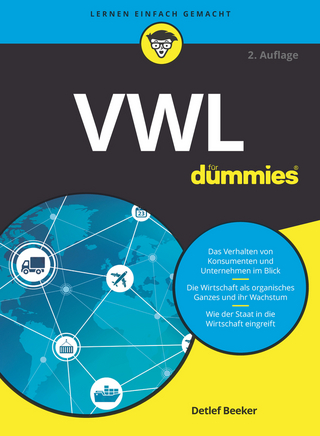
Economics
John Wiley & Sons Inc (Verlag)
978-0-471-67946-2 (ISBN)
- Titel ist leider vergriffen;
keine Neuauflage - Artikel merken
Designed for the Survey of Economics course, the eighth edition of "Economics: Theory and Practice" introduces students to basic economic concepts, institutions, relationships, and terminology. This book prepares students to use economic thinking in their classes, careers, and everyday lives.
Patrick Welch is an Economics professor in the John Cook School of Business at Saint Louis University. He received his B.A. from Marquette and his Ph. D. from the University of Pittsburgh. Research interests include: history of economic thought, industrial organization, and antitrust economics.
Preface. PART ONE: Introduction to Economics. CHAPTER 1. Introduction to Economics. What Is Economics? Economics and Scarcity. Scarcity and Choice. Application 1.1: The Cost of Holding a Job. Efficiency and Equity. Factors of Production. Factors and Income. Scarce Resources. Economic Theory and Policy. Application 1.2: How Much Do I needto be Happy? Economic Theory. Application 1.3: OK, What Are They? Economic Policy. Up for Debate: Should the City Council of Webster Groves, Missouri, Change Its Ordinances to Permit the Sale of Beer in Gasoline Stations? Tools of the Economist. Words, Graphs, and Mathematical Equations. Scarcity, Model Building, and Graphs. Modeling Scarcity. Interpreting the Model. Test Your Understanding: Production Possibilities. Macroeconomics and Microeconomics. Critical Thinking Case 1: Rethinking Medical Care. CHAPTER 1. APPENDIX Graphing. CHAPTER 2. Economic Decision Makingand Economic Systems. Scarcity and Society's Basic EconomicDecisions. Economic Systems and the Three Basic Economic Decisions. Traditional or Agrarian Economies. Economic Decisions in a Traditional Economy. Up for Debate 2.1: Is Western-Style Development Appropriate for Other Cultures? Market Economies. The Operation of a Market Economy. Economic Decisions in a Market Economy. Application 2.1: Missing the Market. Evaluating Market Economies. Government Intervention in a Market Economy: A Mixed Economy. Planned Economies. Economic Decisions in a Planned Economy. Evaluating Planned Economies. Mixed Economies. Test Your Understanding: Economic Decision Making and the Circular Flow. Changing Economic Systems. The Realities of Economic Change. Application 2.2: The People's Republic of China. The U.S. Economic System. The British Foundations of the U.S. Economy. Historical Highlights in the Development of the U.S. Economy. Application 2.3: The Factory Girl's Last Day. Critical Thinking Case 2: Judging Economies. CHAPTER 3. Demand, Supply, and Price Determination. Demand and Supply. Demand: The Buyer's Side. Supply: The Seller's Side. Market Demand, Market Supply, and Price Setting. Market Demand and Market Supply. Markets and Price Setting. Application 3.1: The Laws of Demand and Supply. Equilibrium Price and Equilibrium Quantity. Changes in Quantity Demanded and Quantity Supplied. Changes in Demand and Supply. Changes in Demand. Changes in Supply. Application 3.2: The Rise and Fall of Low Carbs. Changes in Quantity Demanded or Supplied versus Changes in Demand or Supply: A Crucial Distinction. Changes in Equilibrium Price and Equilibrium Quantity. Effect of an Increase in Demand. Effect of a Decrease in Demand. Effect of an Increase in Supply. Effect of a Decrease in Supply. Effect of Changes in both Demand and Supply. Test Your Understanding: Changes in Demand and Supply. Limiting Price Movements. Price Ceilings. Price Floors. Application 3.3: Is Rent Control a Good Thing or a Bad Thing? Up for Debate: Is It a Mistake to Raise the Minimum Wage? Price Elasticity of Demand and Supply. Price Elasticity of Demand. Price Elasticity of Supply. Application 3.4: Moving in a New Direction. Critical Thinking Case 3: How Do Supply and Demand Work in Health Care? CHAPTER 3. APPENDIX Measuring Price Elasticity. PART TWO: The Macroeconomy. CHAPTER 4. Goals and Problems of the Macroeconomy: Employment, Prices, and Production. Unemployment and Full Employment. Consequences of Unemployment. Types of Unemployment. Application 4.1: What's at Stake When a Job Is Lost? Employment and Unemployment: Measures and Statistics. The Goal of Full Employment. Inflation and Stable Prices. Consequences of Inflation. Causes of Inflationary Pressure. Measures of Inflation. Deflation and Disinflation. Application 4.2: When Will This End? Production. Full Production and Economic Growth. Measures of Production. Does GDP Tell the Whole Story? Test Your Understanding: Calculating Price Indexes and GDP. Application 4.3: The Ballad of Joe and Mary. Productivity. Up for Debate: Do Economic Statistics Tell Us How We Are Doing? A Possible Policy Problem. Critical Thinking Case 4: Statistics and Decision Making. CHAPTER 5. Foundations of the Macroeconomy. Changes in Macroeconomic Activity. Business Cycles. Causes of Economic Fluctuations. Total Spending and Macroeconomic Activity. The Household Sector. The Business Sector. Up for Debate: Is Saving a Healthy Habit? Application 5.1: Interest Rates and Investment Spending. The Government Sector. The Foreign Sector. Summary of Aggregate Spending, Leakages, and Injections. The Multiplier Effect. Application 5.2: What's Causing the Economy to Change? Application 5.3: Ripples through the Economy. AWord about Inflation. AWord about Expectations. Test Your Understanding: Changes in Economic Activity. Macroeconomic Policies. Critical Thinking Case 5: President Truman's Desperate Wish. CHAPTER 6. The Role of Government in the Macroeconomy. Government Expenditures and Revenues. Government Expenditures. Government Revenues. Progressive, Proportional, and Regressive Taxes. Up for Debate: Should the Federal Income Tax Be Changed to a Flat Tax? Application 6.1: A Chronology of Federal Income Tax Policies. Tax Reform and Issues. Fiscal Policy. The Mechanics of Fiscal Policy. Discretionary and Automatic Fiscal Policy. Government Budgets. Types of Budgets. Application 6.2: Between a Rock and a Hard Place. The Budget and Fiscal Policy: Tying Them Together. The Realities of Fiscal Policy and the Federal Budget. Test Your Understanding: Government's Impact on the Macroeconomy. The National Debt. Financing the National Debt. Application 6.3: U.S. Treasury Securities. Size of the National Debt. Assessing the Debt. Crowding Out. Critical Thinking Case 6: NIMBY (Not In My Back Yard). CHAPTER 7. Money, Financial Institutions, and the Federal Reserve. Money. The Definition and Functions of Money. Application 7.1: Fixed Assets, or: Why a Loan in Yap Is Hard to Roll over. The Money Supply. Financial Depository Institutions. Commercial Banks. Application 7.2: Am I Covered? Other Financial Depository Institutions. The Federal Reserve System. Organization of the Federal Reserve System. Functions of the Federal Reserve Banks. Test Your Understanding: Changes in a Bank's Reserve Account. Recent Trends in Financial Institutions. Legislative Changes. Up for Debate: Do We Want Banks Moving into Nonbanking Activities? Structural Changes. Application 7.3: 500 Billion Dollars. Critical Thinking Case 7: Cigarette Money. CHAPTER 8. Money Creation, Monetary Theory, and Monetary Policy. The Money Supply and the Level of Economic Activity. The Equation of Exchange. Money Creation. The Process of Money Creation. Application 8.1: Questions and Answers about Reserves and Loans. The Multiple Expansion of Money. Excess Reserves, Interest Rates, and the Level of Spending. Determining Interest Rates on Loans. Application 8.2: An Interest Rate Primer. The Federal Reserve and Monetary Policy. Monetary Policy Tools. Test Your Understanding: Financial Depository Institution Calculations. Application 8.3: Who Is the Most Powerful Person in the United States? Government Deficits and Monetary Policy. Advantages and Disadvantages of Monetary Policy. Up for Debate: Should the Federal Reserve Be Placed under the Direct Control of Congress? Critical Thinking Case 8: The Fed and the Great Depression. CHAPTER 9. Macroeconomic Viewpoints and Models. Macroeconomic Model Building. Application 9.1: Paying Close Attention to Models: It's Worth the Effort. Viewpoints and Models. Classical Economics. Application 9.2: The Academic Scribblers. Keynesian Economics. New Classical Economics. New Keynesian Economics. Monetarism. Supply-Side Economics. Up for Debate: Should Government's Role in Influencing Economic Activity Be Reduced? Inflation and Unemployment. The Phillips Curve. A Final Word on Macroeconomic Viewpoints. Test Your Understanding: Unemployment and Inflation. Critical Thinking Case 9: Does Anyone Care What Economists Think? PART THREE The Microeconomy. CHAPTER 10. Households and Businesses: An Overview. Overview of Households. Household Income and Expenditures. Goals and Decisions of Individuals in Households. Application 10.1: Family Gossip. Overview of Business. Application 10.2: You Decide. Legal Forms of Business. Numbers and Sizes of Businesses. Business Ownership of Business. Test Your Understanding: The Price of Stock Shares. Goals and Decisions of Business Firms. Application 10.3: Two Profiles: Starbucks and Kraft Foods. Up for Debate: Should Profitable Businesses Be Expected to Actively Participate in Improving Their Communities? Critical Thinking Case 10: Time to Maximize. CHAPTER 11. Benefits, Costs, and Maximization. Balancing Benefits and Costs: The Individual. Defining Benefits and Costs. Measuring Benefits and Costs. Maximizing Satisfaction. Application 11.1: Do it Yourself. Graphing Costs, Benefits, and Net Benefit. Balancing Benefits and Costs: The Business. Defining Benefits and Costs. Measuring Revenues and Costs. Maximizing Profit. Graphing Costs, Revenues, and Profit. Test Your Understanding: Maximizing Profit. Social Benefits and Costs. Maximizing Society's Net Benefit. Application 11.2: The Cost of Smoking. Up for Debate: Should States Try to Attract Gambling Casinos? Public Choice. Maximizing Behavior and the Voting Process. Critical Thinking Case 11: Water, Water Everywhere, but Not Enough to Drink. CHAPTER 12. Production and the Costs of Production. Production Basics. Sectors and Industries. Methods of Production. Application 12.1: Searching for a Better Way. Application 12.2: Going the Way of the Victrola. Economic Time, Production, and the Costs of Production. Short-Run Costs. The Pattern of Short-Run Costs. The Law of Diminishing Returns. Test Your Understanding: Calculating Costs and Averages. Up for Debate: Do Wellness Programs Lower Costs for Employers? Long-Run Costs. Application 12.3: A Distance-Ed Student Puts His Lessons to Work on a Farm. Critical Thinking Case 12: The Human Factor. CHAPTER 12. APPENDIX A Further Look at Short-Run Average and Marginal Costs. CHAPTER 13. Competition and Market Structures. Defining a Market. Application 13.1: Defining the Boundaries of a Market: The NCAA Case. The Market Structures. Pure Competition. Characteristics of Pure Competition. Behavior of a Firm in Pure Competition. Application 13.2: Selling Corn, Beans, and Wheat Is There Pure Competition? Monopolistic Competition. Characteristics of Monopolistic Competition. Behavior of a Firm in Monopolistic Competition. Up for Debate: Would We Be Better Off with Less Advertising? Oligopoly . Characteristics of Oligopoly. Behavior of a Firm in an Oligopolistic Market. Application 13.3: The Summer of 2005 387 Monopoly. Characteristics of Monopoly. Behavior of a Monopolist. Market Structures, the Consumer, and Efficiency. Critical Thinking Case 13: The $800 Haircut. CHAPTER 13. APPENDIX Determining the Profit-Maximizing Price and Output for a Firm. Test Your Understanding: Maximizing Profit and Minimizing Loss. CHAPTER 14. Government and the Markets. Antitrust Enforcement. The Antitrust Laws. Application 14.1: Cases Involving the Sherman Act. Application 14.2: Cases Involving the Clayton Act and Its Amendments. Application 14.3: Price-Fixing Settlement Suits Woman Just Fine. Government Regulation. The Structure of Regulation. Industry Regulation. Social Regulation. The Performance of Regulation. Test Your Understanding: Government and Business. Up for Debate: Has Our Enthusiasm for Regulation Gone Too Far? Critical Thinking Case 14: The Limits of the Public Interest. CHAPTER 15. Labor Markets, Unions, and the Distribution of Income. Labor Markets. The Demand for Labor. The Supply of Labor. Test Your Understanding: A Small Business Determines Its Demand for Employees. Changes in Labor Demand and Supply. Application 15.1: For Teenagers, Fast Food Is a Snack, Not a Job. Application 15.2: Last Stitches Sew Up Shroud. Modifications of the Labor Demand and Supply Model. Labor Unions. Types of Unions and Union Membership. Collective Bargaining and Strikes. Collective Bargaining and the Law. The Distribution of Income. Differences in Income. Application 15.3: Making the Most of Intellectual Capital. Poverty. Application 15.4: Michael Dodge. Up for Debate: Should We Place More Demands on Those Seeking Public Assistance? Critical Thinking Case 15: What Is a Fair Distribution of Income? PART FOUR: The International Economy. CHAPTER 16. International Trade. An Overview of U.S. International Trade. The Size and Composition of U.S. Trade. Application 16.1: Owning Up to What's Going On. Comparative Advantage and International Trade. Scarcity and Specialization. The Principle of Comparative Advantage. Test Your Understanding: Comparative Advantage. Free Trade and Protectionism. Trade-Restricting Policies. Free Trade Arguments. Protectionist Arguments. The Real World of International Trade. Application 16.2: Gloria Flunks the Professor. Up for Debate: Should We Impose Sanctions on Products Made by Child Labor? Critical Thinking Case 16: A Petition (by Frederic Bastiat, 1801-1850). CHAPTER 17. International Finance. Exchanging Currencies. Exchange Rates. The Determination of Exchange Rates. Understanding Foreign Exchange Markets. Application 17.1: Foreign Exchange Markets. Application 17.2: Does a Lower-Valued Dollar Help the Economy? Test Your Understanding: Changes in Exchange Rates. International Financial Transactions and Balances. The Current Account. The Capital Account. Balancing the Accounts. Challenges to the International Financial System. The External Debt Crisis. Monetary Integration in Europe. Up for Debate: Euro-dreams. Critical Thinking Case 17: Helping Poor Countries. Glossary. Answers to "Test Your Understanding". Index.
| Erscheint lt. Verlag | 27.10.2006 |
|---|---|
| Zusatzinfo | Illustrations |
| Verlagsort | New York |
| Sprache | englisch |
| Maße | 204 x 252 mm |
| Gewicht | 872 g |
| Einbandart | Paperback |
| Themenwelt | Wirtschaft ► Volkswirtschaftslehre |
| ISBN-10 | 0-471-67946-1 / 0471679461 |
| ISBN-13 | 978-0-471-67946-2 / 9780471679462 |
| Zustand | Neuware |
| Haben Sie eine Frage zum Produkt? |
aus dem Bereich


